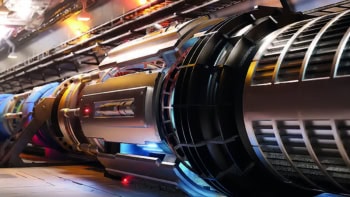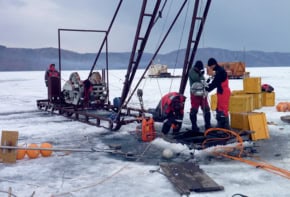Physicists remain convinced that the elusive Majorana particle will be found, despite the retraction of a paper claiming its discovery, as Alexander Hellemans reports

A high-profile publication that claimed to have discovered the elusive Majorana quasiparticle has been retracted after a re-analysis found no such evidence. In 2018 Leo Kouwenhoven from the Delft University of Technology (TU Delft) and colleagues declared they had found the particle in an extremely thin semiconductor nanowire covered by a superconducting layer (Nature 556 74). Yet on 8 March Nature published a retraction after “inconsistencies” with the original analysis came to light. An independent report commissioned by TU Delft, however, found no instances of data fabrication.
The Majorana fermion, a particle that is its own antiparticle, is the brainchild of Italian theoretical physicist Ettore Majorana, who disappeared mysteriously in 1938 after boarding a ferry from Naples to Palermo. It is not a discrete particle but a quasiparticle and consists of two paired electrons. The pair exist in two energy states as well as in a superposition state, just like “qubits” that consist of electrons or photons.
How and where to search for the Majorana particle remained elusive until work in the 2010s by two research groups. Sankar Das Sarma and co-workers from the University of Maryland proposed looking for the Majorana in nanowires consisting of semiconductor-superconductor heterostructures (Phys. Rev. Lett. 105 077001). Then, in 2012 Kouwenhoven and his international team at the QuTech lab at TU Delft published a paper hinting at their existence in semiconductor-superconductor nanowires (Science 336 1003). Physics World picked the finding as one of its top 10 Breakthroughs of the Year.
If we do not deliver eye-popping breakthroughs, the entire research direction gets cancelled and we need to do something else
Sergey Frolov
Four years later, Microsoft set up the Microsoft Quantum Lab at TU Delft in 2016, with Kouwenhoven as its director. In 2018 he and his team published the paper in Nature claiming to have detected the Majorana quasiparticle in an extremely thin semiconductor nanowire covered by a superconducting layer. At a temperature of 0.02 K, they showed that two electrons paired up at the end of the wire with one electron in the semiconducting part and the other electron in the superconducting layer. However, the team could only prove the existence of one electron pair and not the existence of the second electron pair that together would have formed a Majorana qubit.
Several physicists, though, were unconvinced. Sergey Frolov at the University of Pittsburgh and Vincent Mourik at the University of New South Wales independently analysed the result, discovering “several inconsistencies” that led them to conclude there was no proof of a Majorana qubit. As a result of these criticisms, Kouwenhoven and co-workers re-analysed the raw data and rebuilt the experimental set-up to recalibrate certain parameters – finding that the results were inconsistent with a quantized Majorana conductance. “We apologize to the community for insufficient scientific rigour in our original manuscript,” the authors wrote in a retraction published on 8 March (Nature 10.1038/s41586-021-03373-x).
On the same day as the retraction, an independent report written by four physicists that was commissioned by TU Delft concluded there were no instances of data fabrication. “There was some degree of data selection in what was published,” says Patrick Lee from Massachusetts Institute of Technology, who was one of the authors of the report. “I don’t think this was done with malice. I think they were caught up at the excitement of the moment.” Lee notes that “some mistakes” were made by the team such as a calibration error, which they discovered after the publication of the paper. “They were aware of it and they came out with it without holding back anything,” says Lee. Indeed, Lee adds that he does not think that Microsoft is in trouble given its links to TU Delft. “It is a setback, but it should not derail the whole enterprise,” adds Lee. Evidence mounts for Majorana quasiparticles in solids
Frolov says that quantum research is vulnerable to mistakes given it is complex science and that many teams are racing to build quantum computers. “We do not have the luxury of being supported to do the same thing for decades – we operate on 3- to 5-year grant-renewal cycles,” says Frolov. “And if we do not deliver eye-popping breakthroughs, the entire research direction gets cancelled and we need to do something else. This is the root cause of hype that we get criticized for.” Frolov adds that researchers will now have to look for different ways of creating Majorana qubits.
Theoretical physicist Michael Wimmer from TU Delft says that some in the field are now using “Majorana mode” for condensed-matter systems to distinguish it from the “fundamental” particle. “From a theoretical perspective, we know that it is possible to make Majorana modes in a suitable system – the theory behind it is well understood,” he says. “The question is whether such conditions were successfully achieved in an experiment so far.” Meanwhile, Das Sarma says that the retraction of the Delft paper “means little to the subject”. He is convinced that his group’s findings stand and says the ones from Delft will too. “The same experiment with better samples should show Majorana [particles],” he says.



